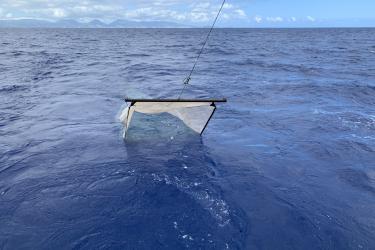Conducting research at the ecosystem level requires the use of various complex scientific instruments and sampling gear. This gear was crucial for at-sea research missions like the recent Bigeye Tuna Oceanography research mission effort that took place aboard the NOAA Ship Oscar Elton Sette. The pelagic ecosystem is a vast and complex region that supports the largest and most valuable fishery in Hawai‘i: the longline fishery. While it may be tempting to focus solely on these top predators, ongoing research at the Pacific Islands Fisheries Science Center’s Pelagic Research Program aims to characterize the ecosystem and understand the current and future ocean conditions that are essential for these species to thrive. This includes gaining a deeper understanding of the pelagic food web—from tiny plankton all the way up to ahi and swordfish—who eats whom? The Bigeye Tuna Oceanography research mission focused on why ocean hotspots attract and aggregate large predators.
To ensure the sampling gear and tools needed for important missions like these are working properly before scientists set sail, teams conduct field trials to test and ready them before the big show begins. For this mission, our team tested bongo nets, several midwater trawls, and the Conductivity, Temperature, Depth (CTD) sampler. This gear also depends on the ship’s winches to work properly to set them down to their intended depths (up to 600 meters) and bring them back up to the ship. The winches’ reels contain heavy duty wire that attach the nets to the ship, and lower and raise them in the water.
Trials to Avoid Tribulations
Preparation makes for successful missions. To make the most of our time at sea, we conduct gear trials prior to the actual start of research missions. We identify any potential issues and resolve them before interrupting scientific operations. During this time, both the ship’s crew and scientists are also trained in safe operations.
Ahead of the Bigeye Oceanography research mission, we tested the nets used for capturing plankton and micronekton, which are small organisms that range in size between plankton (<2 cm) that drift with the currents, and the larger micronekton (>10 cm) that have the ability to swim freely without being significantly impacted by currents. Micronekton include squid, shrimp, mesopelagic fish, as well as larvae and juveniles of larger pelagic fish. Testing encompasses setting the nets to ensure that the winches can deploy and recover the nets safely, so that the nets ‘fly’ correctly in the water, and that the nets are able to capture their target species.
Gear trials for this particular mission also included calibrating the Oscar Elton Sette’s EK80 acoustic system. This sonar system enables scientists to “see” objects in the water column, including the deep scattering layer. This particular layer in the water column consists of zooplankton and micronekton, which undertake the largest migration on Earth. They migrate from deeper depths to shallower waters at night to feed before descending back to deeper waters during the day to evade predators. We calibrate this sonar system so that we collect the precise depth information needed to accurately deploy our nets for sample collection.
The ship’s crew and the scientists, while all experienced mariners, had varying experience with the gear that was tested. More experienced team members shared their knowledge by demonstrating the standard ways of operating gear while other team members brought new perspectives to the operations.
Geared Up
Overall, training went very well and everyone was satisfied with the safety and operational preparations made for this mission. Crew, scientists, and sampling gear were prepared for the Bigeye Oceanography mission, and we look forward to seeing the results of this important work. In the meantime, we invite you to join us out at sea—follow the mission photo gallery to see the operations we’ve prepared for and all of our findings!







